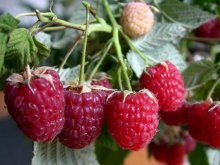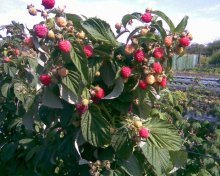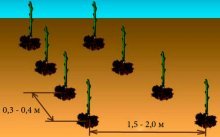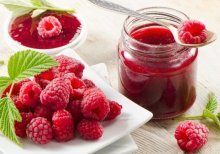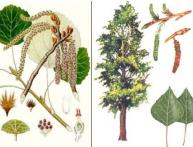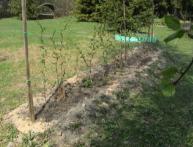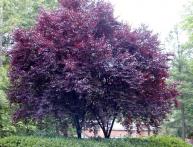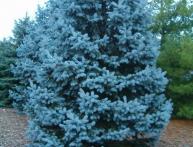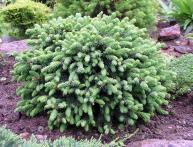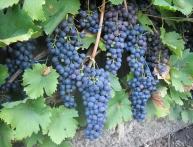Indian summer raspberry variety, features, growing technology

Raspberries associated with amazing aroma and taste, warm summer days. Contains a lot of vitamins and nutrients and has unique healing properties. It is not surprising that almost all summer residents plant it. The Indian Summer raspberry variety is often chosen, the description of which speaks of its advantages. What are the features berries and why do they love her?
Content:
- What is the Indian Summer variety?
- Features of planting raspberries
- How to care for a plant
- Pest and disease exposure, prevention
- Benefits of berries, methods of preparation
What is the Indian Summer variety?
The main advantage of the variety is its repairability. The natural desire of a gardener is to get a harvest for as long as possible. The Indian Summer raspberry variety allows you to pick berries not only in summer, but also in autumn. Bred by breeder I.V. Kazakov.
The first wave of fruiting begins from June to mid-July. The second is from September until frost.
The berry itself is characterized by its small size (about 2.5 g) and neat shape. The big advantage is that raspberries does not lose its sweetness and does not sour even with a lot of rain. The aroma is not pronounced. They have the shape of a rounded cone.
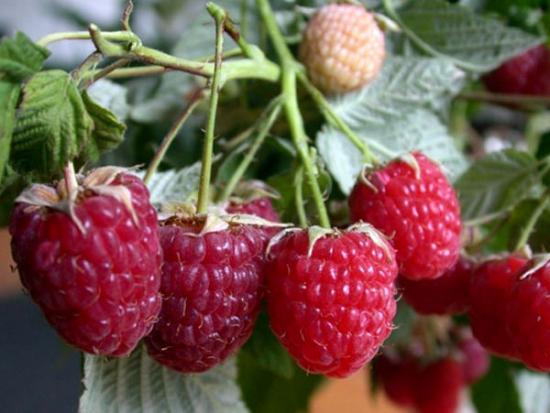
Since the pulp is very tender, transportability is low. The best option would be to process it directly on site or eat it fresh. The yield is average, from one bush you can get from 1 to 1.5 kg.With proper care and favorable weather conditions, you can harvest twice as many fruits.
The bushes are small - the height does not exceed 1.5 m. The branches are not spreading, the plant has a rather neat appearance, and picking fruits is easy and convenient.
Raspberries resistant to a large number of common diseases (gray rot). With a sufficient layer of snow, it tolerates frosts down to -30 C. However, even in good conditions it rarely forms new shoots.
The raspberry variety Indian Summer 2 has also been developed, which differs from its brother in higher yield. It grows shoots more actively. The fruits are larger, weighing about 4 g. They tolerate winter well.
Features of planting raspberries
The most favorable time for landings For a young plant, the period is considered to be from the end of September to the beginning of October. However, many people plant raspberries in spring or autumn.

The yield and lifespan of the plant depend on how correctly the planting site is chosen. To get the maximum benefit from the Indian Summer variety, plant it correctly:
- choose sunny areas
- periodically change the location of planting any raspberries (at least 5 years must pass)
- protect the bushes from strong winds (make a hedge, plant them near a building)
- monitor the groundwater level (it should not exceed 1.5 m)
- you can’t choose a site where they grew before nightshades culture
- put fertilizer (humus) on the bottom
- compact the roots thoroughly
- after planting, water generously (5-6 liters for each bush)
Options for planting bushes may be as follows.
Rows
One of the most popular methods. We plant raspberries at a distance of up to 1 m from each other. The width between rows is up to 2 m.
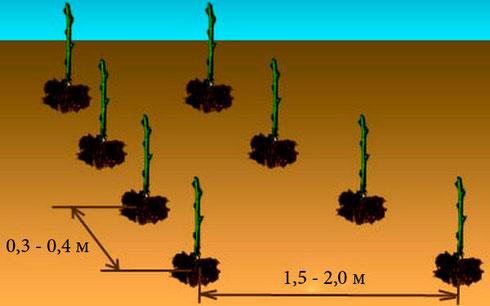
Square
We plant seedlings in the shape of a square. Side length – up to 1.5 m.
The location depends on individual preferences and site characteristics. The main thing is to maintain sufficient distance between plants and comply with planting requirements.
How to care for a plant
Variety raspberries Indian summer, the yield of which is largely determined by weather conditions, does not tolerate drought. Remember about timely watering. In arid climates and without water, the plant dies. If there is no rain, and you cannot water the ground in a timely manner, get drip system glaze.
To retain moisture and provide oxygen access, loosen the soil periodically. The rhizomes are close to the surface, so avoid digging and deep loosening. To protect raspberries from diseases Weeds should be removed regularly.
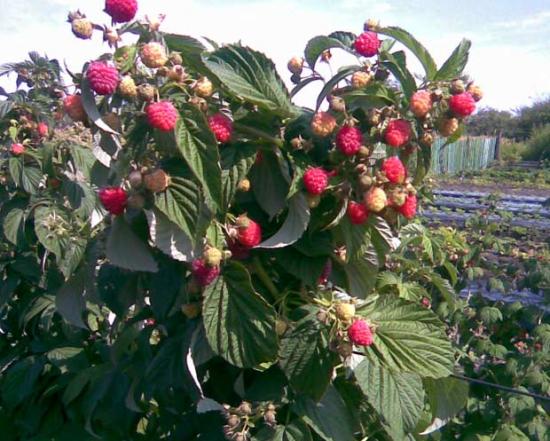
Quality care also includes the following:
Fertilizer
Start off fertilize raspberries should be grown in mid-spring. Apply fertilizer containing nitrogen. Chicken manure diluted with water in a ratio of 1 to 20 is perfect. Starting from the second half of summer, they switch to mineral fertilizers. A mixture of 20 g of potassium sulfate, 15 g of saltpeter and 40 g of superphosphate is prepared in a bucket of water. In the fall, potassium sulphide is taken at the rate of 30 g per 1 sq.m.
Trimming
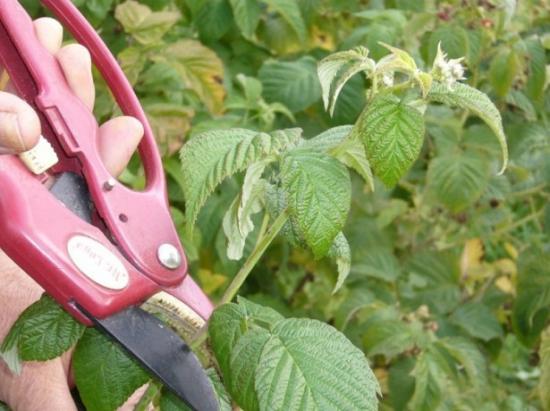
Pruning the Indian Summer variety is not much different from pruning another raspberries. To continue harvesting next year, the stems need to be bent to the ground. Only the weakest ones can be removed. If you want to use the plant as an annual, cut off the shoots at the root.
Pest and disease exposure, prevention
The Indian Summer variety is susceptible to some diseases.To save the plant, you should be aware of their signs and methods of elimination.
Diseases
Purple spotting. The appearance of brown spots on young stems. The disease spreads quickly, affecting almost the entire plant. For prevention, raspberries are sprayed in the spring with Hom and 1% Brodsky liquid. If the disease has already affected the shoots, you will have to trim off the areas with spots.
Powdery mildew. A whitish coating forms on the leaves during periods of heat and high humidity. To eliminate, spray with Topaz or Fundazol, diluting according to the instructions.
Leaf mosaic. The leaf changes color in a mosaic pattern. The culprit of the disease becomes aphid. Complete deliverance is unlikely. You will have to destroy the affected stems.
Pests
Raspberry beetle. Berries eaten by a beetle spoil and rot. To get rid of the pest, dilute ½ g of potassium permanganate in a bucket of water. You can purchase special preparations Iskra or Kinmiks.
Raspberry aphid. The leaves curl and wilt. To prevent the kidneys, it is worth treating them with Nitrafen and Karbofos. In case of damage, the diseased areas are cut off.
Spider mite. A common picture is that berries or leaves are entangled in a thin web, the fruits are eaten away. The problem can be eliminated using Actofit or Vermitek.
Timely care and the use of properly selected products will help protect raspberries from damage and death. An attentive owner will immediately notice problems with the plant.
Benefits of berries, methods of preparation
Raspberries can safely be classified as medicinal berries. It is used for medicinal purposes for colds, fever, and chills. Drinks made from fruits relieve inflammation, remove waste and toxins.The berry is recommended for chronic respiratory tract infections, radiculitis, atherosclerosis and low hemoglobin.
Raspberries are enriched with ascorbic acid, vitamins groups B, PP, E. Contains micro- and macroelements necessary for the body (potassium, magnesium, phosphorus, iron), malic, salicylic, citric acids. Carbohydrate content is about 10%. The calorie content of 100 g of product is 38-40 kcal.
Those who grow raspberries on their plots practice different harvesting methods.
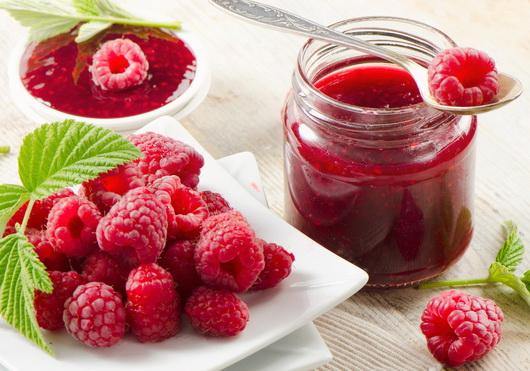
Grinding with sugar
One of the most popular methods of preserving berries for the winter. Blank It is done without cooking, so the berry retains its best properties and vitamins. Raspberries ground with sugar are most often used for medicinal purposes.
Freezing
The simplest and fastest way to enjoy fruits at any time. Good for eating or making compote.
Drying
A labor-intensive method that helps prepare raspberries without taking up much space. For drying, it is better to take slightly unripe berries.
Raspberries – a popular berry among amateur gardeners. The fruits have a delicate sweet-sour taste. Reviews for the Indian Summer raspberry variety are mostly positive.
Among the shortcomings, summer residents note poor transportability.
One of the advantages is that the berry does not become soggy in rainy summers and bears fruit until mid-autumn. They grow it for their own consumption and value it for its excellent medicinal properties.
The secrets of growing remontant varieties of raspberries - on video:


